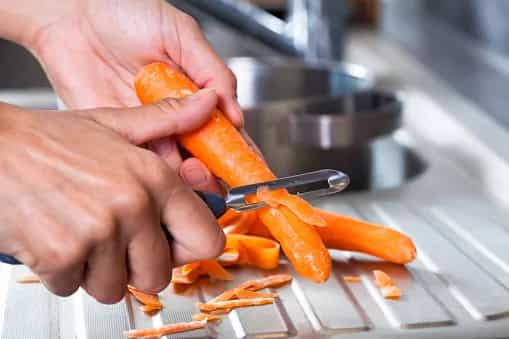Did you know that carrot peels have one-third more fibre than carrots? According to a Tufts University study, carrot peel has more vitamin C and B3 than carrot meat. If you have a tendency of peeling carrots, keep doing so, but don't throw them away. You can use them in other recipes. Here are several intriguing and healthful kitchen uses for carrot peels that you should be aware of.
1. Carrot Peel Chips
Seasoning your carrot peelings with spices and baking them can help to mask the bitter flavour that certain carrots have. To season carrot peels, a drizzle of oil, garlic powder, salt, and dried dill can be a good place to start. You may then use a variety of strong spice blends to amp up the heat, or even sugar and cinnamon to sweeten up your carrot peels. To begin, bake the carrots for six minutes at 400 degrees Fahrenheit, and then continue to check on them until crispy. Because carrot peelings are so thin, they might easily burn if you don't keep an eye on the time. Baked carrot peel chips can be consumed as a healthy snack with dips, crushed into dips and casseroles for crunch, or spread between burgers and sandwiches for crunch.
2. Homemade Stock
Making homemade stock is one of the best and most obvious ways to use carrot peels — or other vegetable peels, for that matter. It really doesn't require much creative flare. You'll also have enough stock to make a variety of elegant stews, soups, braises, and sauces. You can freeze carrot peelings (together with the root and tips) and other vegetable waste until you have a large enough quantity to make a stock with. Serious Eats recommends boiling the peelings and scraps in water for 10 minutes once you're ready. Remove the remnants and you've got yourself some homemade vegetable stock.

3. Pesto
Pesto is typically made with basil leaves, pine nuts, olive oil, and parmesan cheese, but that hasn't prevented people from experimenting with the versatile green sauce. To make your own pesto, include sundried tomatoes, walnuts, pistachios, cilantro, anchovies, and even carrot peels. To make a carrot peel pesto, replace the basil leaves in the pesto with carrot peelings and the pine nuts with walnuts. For added taste, add parmesan, garlic, and salt. Keep the olive oil to a minimum if you want a thick pesto to spread between sandwiches. On the other hand, if you want a thinner pesto to throw the pasta in, add extra oil.
4. Soups
Leftover vegetable peelings can be used to make homemade stock, but they can also be transformed into a hearty winter soup. If the unappealing appearance of carrot peeling is keeping you from using it, you can always boil and combine it with other vegetable peels into a creamy soup. With enough pepper, you won't even notice that the carrot skin is supposed to be bitter. However, make sure to thoroughly wash your carrot peelings before using them. Ideally, wash your carrots for around 30 seconds in lukewarm water to remove any dirt, bacteria, or pesticides from the skin.
5. Garnishing
If you don't mind the look or somewhat bitter flavour of carrot skin, leftover carrot peelings can be a quick and easy way to spice up a dish. Peels from a variety of fruits and vegetables, including carrots, can be used to garnish soups and stir-fries. There are a few strategies you can do to make your carrot peels seem neater if you're using them as garnish. Slicing your carrot peels thinner, more transparent, and shorter might help them look more appealing to consume raw. You can also use alternative tools, such as a zester or a Microplane, to form the peels. You might also try curling the carrot peelings.


